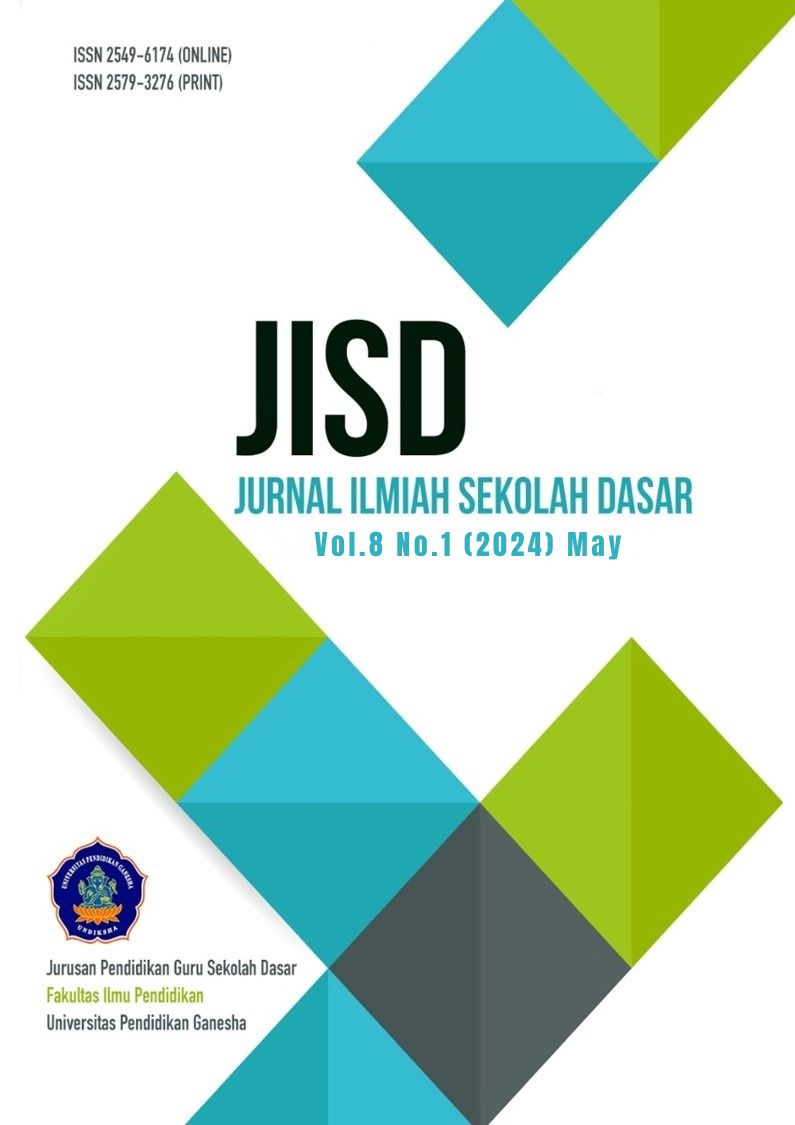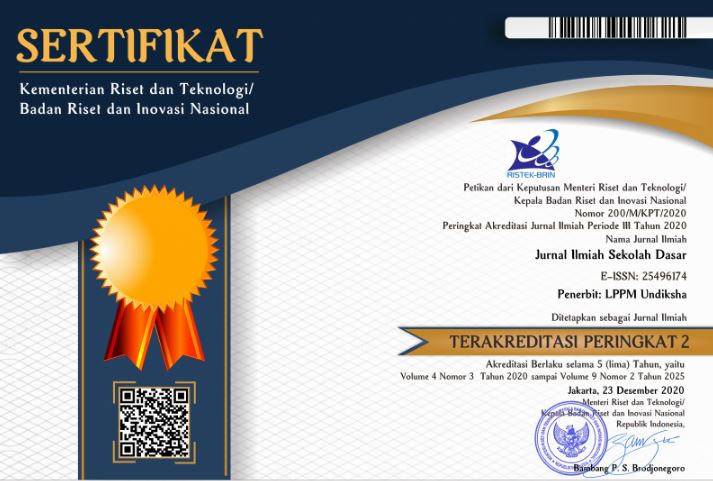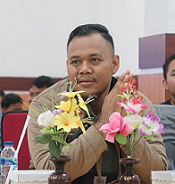Online-based Literacy Test Instruments for Evaluating Prospective Elementary School Teachers’ Science Competencies
DOI:
https://doi.org/10.23887/jisd.v8i2.68342Keywords:
Online-based literacy, Test instrument, Science competenciesAbstract
The Minimum Competency Assessment is used to measure school performance based on literacy and numeracy. In this regard, it is necessary for prospective elementary school student educators to train and master scientific literacy competencies. This research aims to produce an online-based literacy test instrument for assessing the science competency of elementary school teacher education students. This type of research is research and development. The procedure for developing literacy test instruments uses the 4D model (Define, Design, Development and Discussion). This research involved 3 validators and empirical test subjects consisting of 30 Prospective Elementary School Teachers. Data collection uses needs analysis sheets, language validation sheets, materials and graphics. Next, empirical validity is carried out using the Quest program to determine the level of difficulty (Thresholds) and suitability of the items (Outfit-t). The results of the test question instrument validation show that 89.5% of the material validation is in the very good category, 92% of the language validator is in the very good category, 96.5% of the graphic validator is in the very good category. The distribution of questions that have been developed shows that students' ability to identify scientific issues is 66% in the medium category, 65% in explaining scientific phenomena is in the medium category and the ability to use scientific evidence is 45% in the very low category. So the test question instrument developed meets the validity of the material, language, graphics and empirical validity, so it is suitable to be used to measure students' scientific literacy competency.
References
Abdullina, L. R., Ageeva, A. V., & Gabdreeva, N. V. (2019). Using The Flipped Classroom Model in The Teaching of The Theoretical Disciplines (French Language) at The University [Technologie De La Classe Inversee Dans L’enseignement Des Disciplines Theoriques (Fle) Aux Etudiants Des Universites. XLinguae, 12(1), 161–169. https://doi.org/10.18355/XL.2019.12.01XL.12. DOI: https://doi.org/10.18355/XL.2019.12.01XL.12
Abusa’aleek, R. A., & Baniabdelrahman, A. A. (2020). The Effect of Gamification on Jordanian EFL Sixth Grade Students’ Reading Comprehension. International Journal of Education and Training (InjET), 6(1), 1–11. https://www.researchgate.net/profile/Abdallah-Baniabdelrahman-2/publication/343255275. DOI: https://doi.org/10.30564/jiep.v6i2.5525
Adhani, A., Basnawati, B., Zulfadli, Z., Ariesta, C. M., Siska, M., Suhaya, S., & Ramadhan, T. P. (2020). Science Literacy Capability Profile Of Prospective Biology Teachers At The University Of Borneo Tarakan. Biopedagogia, 2(2). https://doi.org/10.35334/biopedagogia.v2i2.1818. DOI: https://doi.org/10.35334/biopedagogia.v2i2.1818
Batlolona, J., Baskar, C., Kurnaz, M., & Leasa, M. (2018). The Improvement of Problem-Solving Skills and Physics Concept Mastery on Temperature and Heat Topic. Jurnal Pendidikan IPA Indonesia, 7(3), 273–279. https://doi.org/10.15294/jpii.v7i3.12432. DOI: https://doi.org/10.15294/jpii.v7i3.12432
Bybee, R., & McCrae, B. (2011). Scientific Literacy and Student Attitudes: Perspectives From Pisa 2006 Science. International Journal of Science Education, 33(1). https://doi.org/10.1080/09500693.2010.518644. DOI: https://doi.org/10.1080/09500693.2010.518644
Cahyana, U., Supatmi, S., Erdawati, & Rahmawati, Y. (2019). The Influence of Web-Based Learning and Learning Independence Toward Student’s Scientific Literacy in Chemistry Course. International Journal of Instruction, 12(4), 655–668. https://doi.org/10.29333/iji.2019.12442a. DOI: https://doi.org/10.29333/iji.2019.12442a
Clarke, T. (2020). Children’s Wellbeing and Their Academic Achievement: The Dangerous Discourse of ‘Trade-Offs’ in Education. Theory and Research in Education, 18(3), 263–294. https://doi.org/10.1177/1477878520980197. DOI: https://doi.org/10.1177/1477878520980197
Cole, J., & Feng, J. (2015). Effective strategies for improving writing skills of elementary English language learners. Chinese American Educational Research and Development Association Annual Conference, 1–25. https://eric.ed.gov/?id=ED556123.
Elmahdi, I., Al-Hattami, A., & Fawzi, H. (2018). Using Technology for Formative Assessment to Improve Students’ Learning. Turkish Online Journal of Educational Technology-TOJET, 17(2), 182–188. https://eric.ed.gov/?id=EJ1176157.
Firmansyah, & Gradini, E. (2020). National Examination Absorption Profile For SMP/MTs Mathematics Subjects In 2019 In Central Aceh District. Jurnal As-Salam, 4(2). https://doi.org/10.37249/as-salam.v4i2.184. DOI: https://doi.org/10.37249/as-salam.v4i2.184
Friatma, & Anhar. (2019). Analysis of Validity, Reliability, Discrimination, Difficulty and Distraction Effectiveness In Learning Assessment. Journal of Physics: Conference Series, 1387(1). https://doi.org/10.1088/1742-6596/1387/1/012063. DOI: https://doi.org/10.1088/1742-6596/1387/1/012063
Gormally, C., Brickman, P., & Lutz, M. (2012). Developing a Test of Scientific Literacy Skills (TOSLS): Measuring Undergraduates’ Evaluation of Scientific Information and Arguments. CBE Life Sciences Education, 11(4), 364–377. https://doi.org/10.1187/cbe.12-03-0026. DOI: https://doi.org/10.1187/cbe.12-03-0026
Hakim, L., Lubis, P. H. M., Lefudin, L., & Sulistyowati, R. (2022). The Relationship between Learning Style toward Mastery of Concepts and Problem Solving Skill Introduction to Nuclear Physics for Pre-Service Teacher. Jurnal Penelitian Pendidikan IPA, 8(2), 666–673. https://doi.org/10.29303/jppipa.v8i2.1176. DOI: https://doi.org/10.29303/jppipa.v8i2.1176
Holbrook, J., & Rannikmae, M. (2009). The Meaning of Scientific Management. The Contributions of Alexander Hamilton Church to Accounting and Management, 4(3), 275–288. https://doi.org/10.4324/9781003056584-3. DOI: https://doi.org/10.4324/9781003056584-3
Izhar, G., Wardani, K., & Nugraha, N. K. (2022). The Development Enviromental Literacy Media Learning for Elementary School Student. Journal of Innovation in Educational and Cultural Research, 3(3), 397–404. https://doi.org/10.46843/jiecr.v3i3.116. DOI: https://doi.org/10.46843/jiecr.v3i3.116
Jufrida, J., Basuki, F. R., Kurniawan, W., Pangestu, M. D., & Fitaloka, O. (2019). Scientific Literacy and Science Learning Achievement at Junior High School. International Journal of Evaluation and Research in Education, 8(4), 630–636. https://doi.org/10.11591/ijere.v8i4.20312. DOI: https://doi.org/10.11591/ijere.v8i4.20312
Kelana, J. B., Wardani, D. S., & Wulandari, M. A. (2021). Learning Methods and Critical Thinking Ability on Science Learning Outcomes. Jurnal Ilmiah Sekolah Dasar, 5(1), 69–76. https://doi.org/10.23887/jisd.v5i1.29940.
Kibirige, I., & Teffo, W. L. (2014). Actual and Ideal Assessment Practices in South African Natural Sciences Classrooms. International Journal of Educational Sciences, 6(3), 509–519. https://doi.org/10.31901/24566322.2014/06.03.1. DOI: https://doi.org/10.1080/09751122.2014.11890162
Lederman, N. G., Lederman, J. S., & Antink, A. (2013). Nature of Science and Scientific Inquiry as Contexts for the Learning of Science and Achievement of Scientific Literacy. International Journal of Education in Mathematics Science and Technology (IJEMST) International Journal of Education in Mathematics Science and Technology International Journal of Education in Mathematics Science and Technology, 1(3), 138–147. https://eric.ed.gov/?id=ED543992.
Martinah, A. A., Mubarok, V., Miarsyah, M., & Ristanto, R. H. (2022). Development of Contextual-Based Science Literacy Test Instruments on Environmental Pollution Materials. Bioedusiana: Jurnal Pendidikan Biologi, 6(2), 192–218. https://doi.org/10.37058/bioed.v6i2.3251. DOI: https://doi.org/10.37058/bioed.v6i2.3251
N.M.S. Yantiningsih, I.W. Suastra, & D.B. Sanjaya. (2022). Development of Scientific Literacy Instruments and Learning Outcomes for Class VI Elementary School Students. PENDASI Jurnal Pendidikan Dasar Indonesia, 6(1), 13–23. https://doi.org/10.23887/jurnal_pendas.v6i1.531. DOI: https://doi.org/10.23887/jurnal_pendas.v6i1.531
Novita, R., & Putra, M. (2016). Using Task Like PISA’s Problem to Support Student’s Creativity in Mathematics. Journal on Mathematics Education, 7(1), 31–4. https://doi.org/10.22342/jme.7.1.2815.31-42. DOI: https://doi.org/10.22342/jme.7.1.2815.31-42
Özer, M., & Bilgisi Öz, M. (2020). What Does PISA Tell Us About Performance of Education Systems? PISA Eğitim Sistemlerinin Performansı Hakkında Bize Ne Söylüyor? Bartın University Journal of Faculty of Education, 9(2), 217–228. https://doi.org/10.14686/buefad.697153. DOI: https://doi.org/10.14686/buefad.697153
Prasetia, I., & Adlan, M. (2022). Management of the Literacy Movement Program (LMP) to Improve Reading Culture in Elementary Schools. Journal of Innovation in Educational and Cultural Research, 3(3). https://doi.org/10.46843/jiecr.v3i3.117. DOI: https://doi.org/10.46843/jiecr.v3i3.117
Pratiwi, S. N., Cari, C., & Aminah, N. S. (2019). 21st Century Science Learning with Students’ Scientific Literacy. Jurnal Materi Dan Pembelajaran Fisika, 9(1), 34–42. https://doi.org/https://doi.org/10.20961/jmpf.v9i1.31612.
Rahmadani, Y., Fitakurahmah, N., Fungky, N., Prihatin, R., Majid, Q., & Prayitno, B. A. (2018). Profil Keterampilan Literasi Sains Siswa di Salah Satu Sekolah Swasta di Karanganyar. Jurnal Pendidikan Biologi, 7(3), 183. https://doi.org/10.24114/jpb.v7i3.10123. DOI: https://doi.org/10.24114/jpb.v7i3.10123
Ramadhan, W., Malahati, F., Romadhon, K., & Ramadhan, S. (2023). Analysis of Multiple Choice Questions Type Items in Elementary School Daily Assessments. Tarbiyah Wa Ta’lim: Jurnal Penelitian Pendidikan Dan Pembelajaran, 10(2), 93–105. https://doi.org/10.21093/twt.v10i2.6155. DOI: https://doi.org/10.21093/twt.v10i2.6155
Richey, R. C., & Klein, J. D. (2014). Design and Development Research. In Handbook of research on educational communications and technology (pp. 141–150). Springer. https://doi.org/https://doi.org/10.1007/978-1-4614-3185-5_12. DOI: https://doi.org/10.1007/978-1-4614-3185-5_12
Rubini, B., Permanasari, A., & Yuningsih, W. (2018). Learning Multimedia Based on Science Literacy on the Lightning Theme. Jurnal Penelitian Dan Pembelajaran IPA, 4(2), 89–104. https://doi.org/10.30870/jppi.v4i2.3926. DOI: https://doi.org/10.30870/jppi.v4i2.3926
Saepuzaman, D., Istiyono, E., & Haryanto. (2022). Characteristics of Fundamental Physics Higher-order Thinking Skills Test Using Item Response Theory Analysis. Pegem Egitim ve Ogretim Dergisi, 12(4), 269–279. https://doi.org/10.47750/pegegog.12.04.28. DOI: https://doi.org/10.47750/pegegog.12.04.28
Saputra, B., & Sujarwanta, A. (2021). Tranformasi Pembelajaran Berbasis Proyek Science, Technology, Engineering and Mathematics di Masa Pandemi Covid-19. BIOLOVA, 2(1), 1–8. https://doi.org/10.24127/biolova.v2i1.491. DOI: https://doi.org/10.24127/biolova.v2i1.491
Sarea, M. S., & Ruslan, R. (2019). Characteristics Of Question Items: Classical Test Theory Vs Item Response Theory? Didaktika : Jurnal Kependidikan, 13(1). https://doi.org/10.30863/didaktika.v13i1.296. DOI: https://doi.org/10.30863/didaktika.v13i1.296
Setyawarno, D. (2017). Effort To Improve The Quality Of Qualifications With Quest Application Analysis.
Siahaan, S. R., Situngkir, D., Nitami, M., & Wahidin, M. (2022). The Relationship Between Job Insecurity and Job Stress and Employee Turnover Intention. Lontara Journal of Health Science and Technology, 3(2). https://doi.org/10.53861/lontarariset.v3i2.304. DOI: https://doi.org/10.53861/lontarariset.v3i2.304
Singh, B. (2019). Character Education in the 21st Century. Journal of Social Studies (JSS), 15(1), 1–12. https://doi.org/10.21831/jss.v15i1.25226. DOI: https://doi.org/10.21831/jss.v15i1.25226
Suharsimi Arikunto. (2021). Dasar-Dasar Evaluasi Pendidikan Edisi 3 (Restu Damayanti (ed.); Ketiga). PT Bumi Aksara.
Sulaiman, S., Radzi, M. Q. A.-N. A., Kamaruddin, N., & Ali, W. A. F. W. (2020). Typography Usage in Multimedia Teaching Aid Interface Design. 502(Imdes), 157–162. https://doi.org/10.2991/assehr.k.201202.070. DOI: https://doi.org/10.2991/assehr.k.201202.070
Downloads
Published
How to Cite
Issue
Section
License
Copyright (c) 2024 Tri Wiyoko, Titis Wulandari, Muhammad Irhas

This work is licensed under a Creative Commons Attribution-ShareAlike 4.0 International License.
Authors who publish with the Journal Ilmiah Sekolah Dasar agree to the following terms:
- Authors retain copyright and grant the journal the right of first publication with the work simultaneously licensed under a Creative Commons Attribution License (CC BY-SA 4.0) that allows others to share the work with an acknowledgment of the work's authorship and initial publication in this journal.
- Authors are able to enter into separate, additional contractual arrangements for the non-exclusive distribution of the journal's published version of the work (e.g., post it to an institutional repository or publish it in a book), with an acknowledgment of its initial publication in this journal.
- Authors are permitted and encouraged to post their work online (e.g., in institutional repositories or on their website) prior to and during the submission process, as it can lead to productive exchanges, as well as earlier and greater citation of published work. (See The Effect of Open Access)










